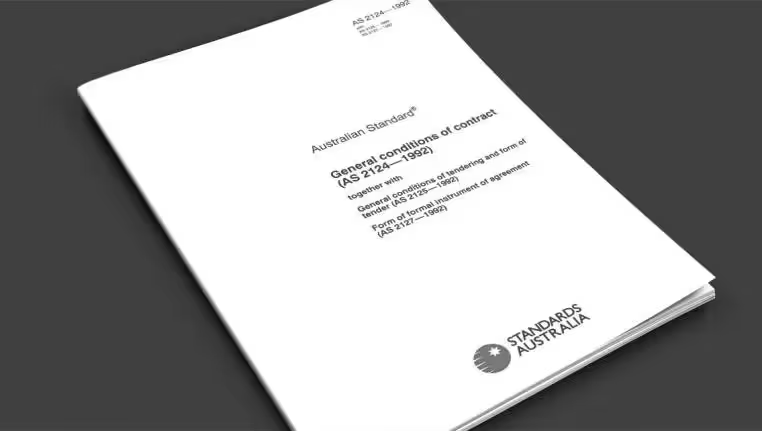Standard forms of construction contracts play an important role in the Australian construction industry by providing a structured and legally recognised framework for capital works project engagements, governing the important roles of contract administrators for client side project managers, construction superintendents, and contractors.
These contracts are often old, developed or owned by slow (but reputable) to change organisations and then heavily amended by legal teams. The final document can therefore be the thickness of a brick and challenging to navigate. Yet, they are instrumental in ensuring the smooth execution of capital works projects and getting everyone paid, which is why Mastt has digitised all major standard forms of construction contracts in Australia.
Let's take a closer look at some of the most popular standard construction contracts used in Australia which provide the foundation for the contractual relationship between:
- The Principal (the party commissioning the construction project, i.e. the Project's Owner)
- The Contractor (the party undertaking the construction work)
1. Australian Standards AS4300
A widely recognised and versatile contract, AS4300-1995 is used across various sectors in Australia. It specifically caters to construction project agreements, offering versatility and clearly defining roles, responsibilities, progress claim protocols, and dispute resolution procedures. This contract is ideal for a whole range of construction projects, except residential buildings involving private individuals as principals.
Read more about AS4300 here.
2. Australian Standards AS4000
The AS4000-1997 stands as a cornerstone for formalising agreements within the construction sector. This standard outlines a detailed framework for managing projects, encompassing the full spectrum of project specifications, adjustments, and mechanisms for resolving disputes.
The flexibility of AS4000-1997 ensures its applicability across a wide range of project sizes, making it a go-to choice for many. However, it tends to be less applicable in projects valued over $500 million and better used in projects below this threshold.
Standards Australia has just released for public consultation its proposed update to AS 4000, but the update is very minimalist and ensures no change to the contract’s 1997 risk allocation. The ‘no change to risk allocation’ mandate was the only basis on which the update could proceed after the last attempt at an update involving changes to the risk allocation imploded.
Read more about AS4000 here.
3. Australian Standards AS2124
Introduced in 1993, the Australian Standards AS2124-1992 remains a preferred contract for its adaptability in the construction industry. Despite its age, the AS 2124 remains relevant by covering essential elements of construction contracts such as progress claims, the rectification of defects, and the administration of the project. It is notably flexible, accommodating modifications to suit various project types across different sectors. However, it is often so extensively modified in practice that its original form becomes almost unrecognisable.
Read read more about AS2124 here. If you are wondering why it's so very old, we explain that here.

4. Australian Standards AS4902
The AS4902-2000 is a vital component of major works forms, providing a foundational framework for substantial construction endeavours. It encompasses detailed provisions for variations to the contract, terms for progress claims, and mechanisms for resolving disputes. Well liked for its ability to manage large and complex construction projects, AS4902-2000 is a preferred standard for overseeing large & significant projects in the construction sector.
Read more about AS4902 here.
5. FIDIC Forms
Owned by the International Federation of Consulting Engineers (FIDIC), FIDIC contracts are globally acknowledged and predominantly used for high-value projects, especially within the private sector's infrastructure and process engineering fields.
FIDIC contracts are distinguished for their balanced approach to risk distribution, comprehensive project specifications, and effective dispute resolution frameworks. Notably, FIDIC contracts are flexible, making them suited for a broad range of project types.
6. GC21 Form
The GC21 Form is predominantly used in New South Wales and Queensland for contracts exceeding $5 million in value, offering a systematic framework for managing projects and addressing numerous facets of construction agreements. Its reception is often mixed, with a general lack of enthusiasm from those who encounter it.
Notably, a GC21 contract includes provisions that allow client side project managers and lawyers to transfer an extensive amount of risk onto contractors—a feature that, while intended to protect client interests, is often viewed with scepticism for its fairness.

7. ABIC MW Form
The ABIC MW form, jointly owned by Master Builders Australia and the Australian Institute of Architects, is designed explicitly for small-value contracts, focusing on the residential sector where private individuals are the owners. This form streamlines the contract administration process, making it more straightforward for smaller-scale residential construction projects.
8. Defence Head Contract (HC-1)
Defence's HC-1 is was developed by the Australian Department of Defence for themselves, focusing on their specific needs as conventional fixed-time construction contracts (who can blame them, with the options above approaching 30 years old!).
HC-1 contract provides versatile pricing options, such as lump sum and schedule of rates, catering to the diverse needs of Defence capital & infrastructure projects. Defence's Security & Estate Group, Capital Facilities & Infrastructure Branch excels in executing projects efficiently and is committed to continually enhancing and updating its range of contracts to ensure optimal performance and adaptability.
9. Defence Design Services Contract (DSC-1)
Defence's DSC-1 is another Defence developed contract, utilised to engage design services consultants for Defence projects under fixed-time, lump-sum agreements. This contract is tailored to meet the unique requirements of design consultancy within the context of Defence construction projects, ensuring that specialised needs are adequately addressed.
10. Defence Managing Contractor Contract (MCC-1)
A unique contract, Defence's MCC-1 allows for the early involvement of contractors in Defence projects through a 'Planning Phase' and covers various aspects of project management, design and construction and subcontractor engagement. Pricing can be comprised of lump sum components; however, it is primarily used for reimbursable costs (like acost plus contract).
The Defence Managing Contract is great if you don't know what to do but want to get started. However, it has recently been considered a more expensive way of constructing assets vs Head Contract-style contracts.

Standard Form Construction Contracts
The contracts reviewed in this blog range from Australian Standards like AS4300 and AS4000, to internationally recognised FIDIC forms and specialised Defence contracts. These contracts are not merely legal documents but the backbone of construction projects, defining roles, responsibilities, progress claim terms, and dispute resolution mechanisms.
Whether you're a client side project manager, a contractor, or someone involved in the construction process, knowing the ins and outs of these contracts can make a significant difference in getting to practical completion without unnecessary issues.
Thank you and as always, follow the legislation for your state and comply with the Security of Payments Act, e.g.:
- New South Wales - Building and Construction Industry Security of Payment Act
- Victoria - Building and Construction Industry Security of Payment Act
- Queensland - Building and Construction Industry Payments Act
- Western Australia - Construction Contracts Act
- Tasmania - Building and Construction Industry Security of Payment Act
- Australian Capital Territory - Building and Construction Industry (Security of Payment) Act
- Northern Territory - Construction Contracts (Security of Payments) Act 2004
- Standard Contract Forms in the Construction Industry
Reporting on AS4000, AS4300 and Standard Form Contracts
Mastt provides a comprehensive platform designed to enhance Contract Administrators on capital projects using AS4000, AS4300, AS4902, AS2124 and Defene Standard Form Contracts. Here’s how Mastt can assist:
- Dashboards and Reporting Automated: Mastt's dashboard offers a centralized view of all project activities, helping project managers track progress and manage tasks effectively.
- Documentation and Tracking: The platform provides tools for documenting and tracking all project-related information, ensuring that everything is recorded and managed systematically.
- Contract Management & Administration: Mastt allows Project Managers to digitally administer Standard Form Contracts like AS4000, AS4300, AS4902, AS2124 and Defene Standard Form Contracts to automate contract payments, Variation and other contract clauses.
- Security of Payments Act: Mastt provides compliance tools to ensure Payment Claims and Payment Certificates are compliant with SOPA.
- Budget & Forecasting: Mastt helps project managers stay on top of budgets and cash flow forecasting by providing real-time insights and analytics.
- Risk Management: By offering robust risk management tools, Mastt enables construction managers to identify and mitigate risks early, ensuring projects stay on track.
- Stakeholder Collaboration: Mastt enhances communication and collaboration between the project owner, contractors, and other stakeholders, ensuring that everyone is aligned and informed.

Contracts and Project Control Groups
Standard Form Construction Contracts are often an agenda item on Project Control Group meetings and within PCG Reports. Learn more about everything PCG related below.
- What is a Project Control Group? Understanding the Role of PCG in Capital Project Management
- The Best PCG Report for PCG Meetings in 2024
- What to Include in a PCG Report (Traditional)
- What to Wear to a PCG Meeting: A Guide for Client Side Project Managers
Disclaimer: While Mastt is dedicated to offering valuable industry insights, it's important to note that we are not legal experts. Therefore, our content should not be interpreted as legal advice. We encourage readers to exercise discretion and seek personalized guidance from qualified legal professionals.






.avif)











.avif)


